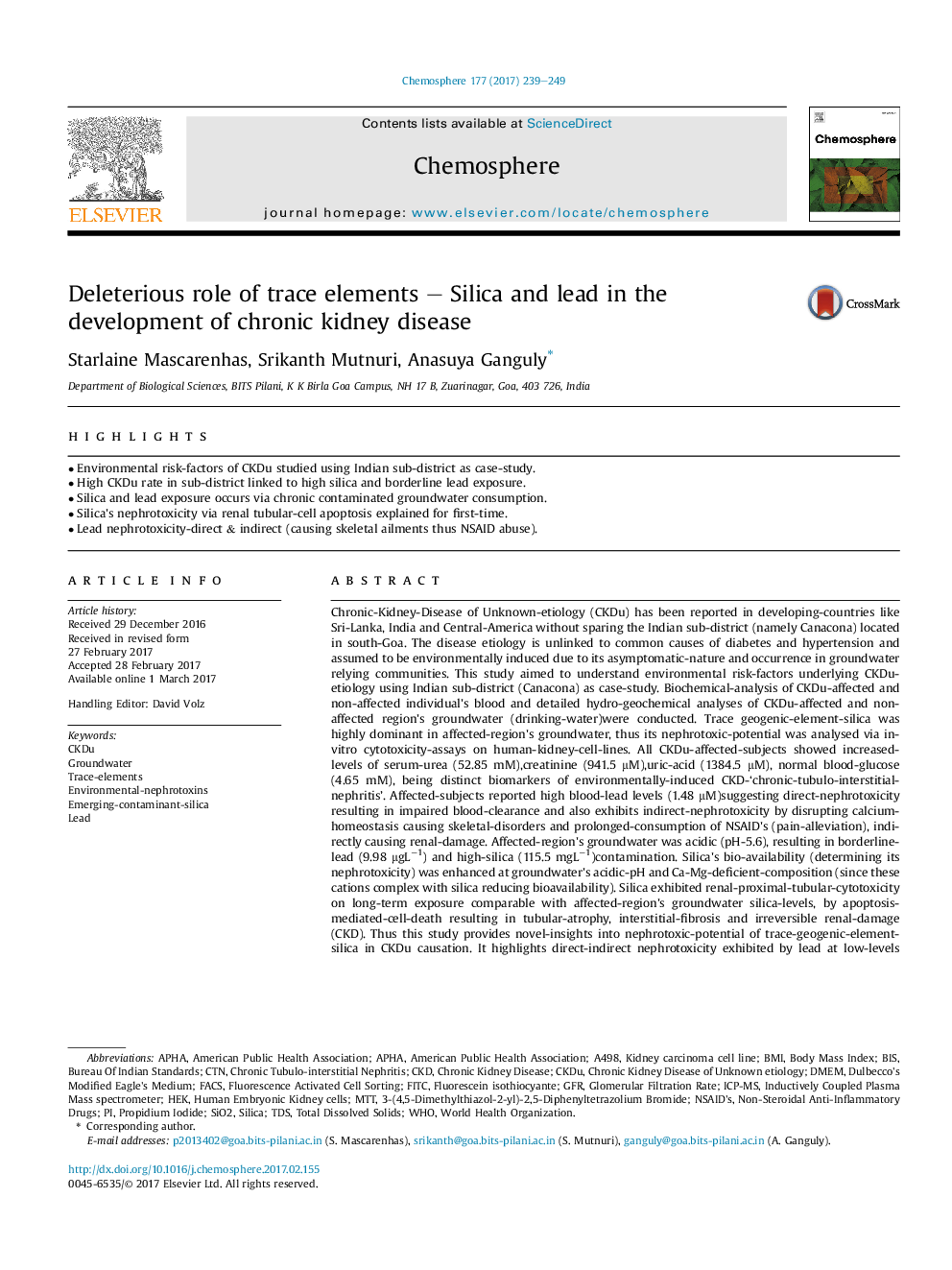| کد مقاله | کد نشریه | سال انتشار | مقاله انگلیسی | نسخه تمام متن |
|---|---|---|---|---|
| 5746300 | 1618794 | 2017 | 11 صفحه PDF | دانلود رایگان |
- Environmental risk-factors of CKDu studied using Indian sub-district as case-study.
- High CKDu rate in sub-district linked to high silica and borderline lead exposure.
- Silica and lead exposure occurs via chronic contaminated groundwater consumption.
- Silica's nephrotoxicity via renal tubular-cell apoptosis explained for first-time.
- Lead nephrotoxicity-direct & indirect (causing skeletal ailments thus NSAID abuse).
Chronic-Kidney-Disease of Unknown-etiology (CKDu) has been reported in developing-countries like Sri-Lanka, India and Central-America without sparing the Indian sub-district (namely Canacona) located in south-Goa. The disease etiology is unlinked to common causes of diabetes and hypertension and assumed to be environmentally induced due to its asymptomatic-nature and occurrence in groundwater relying communities. This study aimed to understand environmental risk-factors underlying CKDu-etiology using Indian sub-district (Canacona) as case-study. Biochemical-analysis of CKDu-affected and non-affected individual's blood and detailed hydro-geochemical analyses of CKDu-affected and non-affected region's groundwater (drinking-water)were conducted. Trace geogenic-element-silica was highly dominant in affected-region's groundwater, thus its nephrotoxic-potential was analysed via in-vitro cytotoxicity-assays on human-kidney-cell-lines. All CKDu-affected-subjects showed increased-levels of serum-urea (52.85 mM),creatinine (941.5 μM),uric-acid (1384.5 μM), normal blood-glucose (4.65 mM), being distinct biomarkers of environmentally-induced CKD-'chronic-tubulo-interstitial-nephritis'. Affected-subjects reported high blood-lead levels (1.48 μM)suggesting direct-nephrotoxicity resulting in impaired blood-clearance and also exhibits indirect-nephrotoxicity by disrupting calcium-homeostasis causing skeletal-disorders and prolonged-consumption of NSAID's (pain-alleviation), indirectly causing renal-damage. Affected-region's groundwater was acidic (pH-5.6), resulting in borderline-lead (9.98 μgLâ1) and high-silica (115.5 mgLâ1)contamination. Silica's bio-availability (determining its nephrotoxicity) was enhanced at groundwater's acidic-pH and Ca-Mg-deficient-composition (since these cations complex with silica reducing bioavailability). Silica exhibited renal-proximal-tubular-cytotoxicity on long-term exposure comparable with affected-region's groundwater silica-levels, by apoptosis-mediated-cell-death resulting in tubular-atrophy, interstitial-fibrosis and irreversible renal-damage (CKD). Thus this study provides novel-insights into nephrotoxic-potential of trace-geogenic-element-silica in CKDu causation. It highlights direct-indirect nephrotoxicity exhibited by lead at low-levels due to its bio-accumulative-capacity. Silica's nephrotoxic-potential can be considered when deciphering etiology of CKDu-problem in developing-countries (relying on groundwater).
Journal: Chemosphere - Volume 177, June 2017, Pages 239-249
